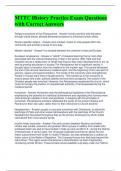Examen
MTTC History Practice Exam Questions with Correct Answers
- Cours
- Établissement
MTTC History Practice Exam Questions with Correct Answers Religious practices of the Shang period - Answer-human sacrifice and divination through oracle bones, allowed deceased ancestors to influence human affairs Roman republic religion - Answer-civic-minded, meant to unite people within the...
[Montrer plus]



